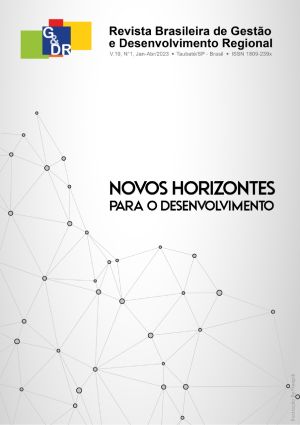SMART FARMING IN BRAZIL: AN OVERVIEW OF TECHNOLOGY, ADOPTION AND FARMER PERCEPTION
DOI:
https://doi.org/10.54399/rbgdr.v19i1.6040Resumo
At the second decade of the 21st century, the use of a new set of agricultural technologies, such as smart farming (SF), emerge among agribusiness organizations and agents. This study aims to identify the smart farming technologies used in grain production systems in Brazil and to verify the perception of the farmers regarding technical assistance for SF. A survey was conducted with farmers and 119 valid observations were collected. The study used non-probabilistic sampling, since it considered grain farmers whose farms produced more than 50% of their gross revenue in grains. Descriptive and content analysis were used to analyze the data. The results indicate that soil sampling is the main precision agriculture technology adopted by the production systems assessed, while smartphone applications to assist in agricultural management are the most used information technology. The machines used in grain production systems are undergoing a digitization process, especially due to the increase in availability of equipment with sensors and automated processes. However, the question remains about the capacity of farmers and assistance agents to monitor and take advantage of the potential of SF technologies in farms.Referências
AEGRO. Software de gestão agrícola. Porto Alegre, 2021. Disponível: <https://aegro.com.br/>. Acesso em: 02 jan. 2021.
BERNARDI, A.C.; INAMASU, R.Y. Adoção da agricultura de precisão no Brasil. In: BERNARDI, A.C.; NAIME, J.M.; RESENDE, A.V.; BASSOI, L.H.; INAMASU, R.Y. (Eds.). Agricultura de precisão: resultados de um novo olhar. São Paulo: Embrapa, 2014. p. 559-577.
CARRER, M. J.; SOUZA FILHO, H. M. de; BATALHA, M. O. Factors influencing the adoption of farm management information systems (FMIS) by Brazilian citrus farmers. Computers and Electronics in Agriculture, v. 138, p. 11-19, 2017.
CNA. Projetos e programas. Brasília, 2020. Disponível em: <https://www.cnabrasil.org.br/projetos-e-programas/?instituicao=cna>. Acesso em: 23 dez. 2020.
ELYSIOS. Agricultura inteligente. Porto Alegre, 2021. Disponível em: <https://elysios.com.br/>. Acesso em: 02 jan. 2021.
FOUNTAS S, C. G; SØRENSEN, C.G.; TSIROPOULOS, Z.; CAVALARIS, C.; VATSANIDOUD, A.; LIAKOS, B; CANAVARI, M.; WIEBENSOHN, J.; TISSERYE B. Farm management information systems: current situation and future perspectives. Computers in Electronics Agriculture, v. 115, p. 40-50, 2015.
FOUNTAS, S.; BLACKMORE, S.; ESS, D.; HAWKINS, S.; BLUMHOFF, G.; LOWENBERG-DEBOER, J.; SORENSEN, C. G.. Farmer experience with precision agriculture in Denmark and the US Eastern Corn Belt. Precision Agriculture, v. 6, n. 2, p. 121-141, 2005. https://doi.org/10.1007/s11119-004-1030-z.
FREEMAN, C.; PEREZ, C. Structural crises of adjustment, business cycles and investment behaviour. In: DOSI, G.; FREEMAN, C.; NELSON, R.; SILVERBERG, G.; SOETE, L. (Eds.). Technical change and economic theory. London: Pinter; 1988. p. 38-66.
GEBBERS, R.; ADAMCHUK, V. I. Precision agriculture and food security. Science, v. 327, n. 5967, p. 828-831, 2010. https://doi.org/10.1126/science.1183899.
HOFF, D.; PEDROZO, E.A.; FREITAS, A.S.; PAVINATO, A. Percurso da difusão da inovação tecnológica no agronegócio: o caso do plantio direto no Rio Grande do Sul. Ensaios FEE, v. 31, n. 2, p. 477-502, 2011. https://revistas.fee.tche.br/index.php/ensaios/article/view/2271/2827.
KRISHNAN, N. Cultivating ag tech: 5 trends shaping the future of agriculture. CB Insights, 2017. Disponível em: <https://www.cbinsights.com/research/agtech-startup-investor-funding-trends/?utm_source=linkedin&utm_campaign=Krishnan&utm_medium=contentteam>. Acesso em: 22 dez. 2020.
LARSON, J. A.; ROBERTS, R. K; ENGLISH, B.C.; LARKIN, S. L.; MARRA, M. C.; MARTIN, S. W.; REEVES, J. M. Factors affecting farmer adoption of remotely sensed imagery for precision management in cotton production. Precision Agriculture, v. 9, n. 4, p. 195-208, 2008. https://doi.org/10.1007/s11119-008-9065-1.
LOSCH, B. Family farming: at the core of the world's agricultural history. In: SOURISSEAU, J.-M. (Ed.). Family farming and the worlds to come. Paris: Springer; 2015. p. 13-36.
MAPA. Ministério da Agricultura, Pecuária e Abastecimento. Principais conceitos e expressões utilizados na agricultura de precisão – AP. Brasília: MAPA, 2012. Disponível em: <https://www.gov.br/agricultura/pt-br/assuntos/sustentabilidade/tecnologia-agropecuaria/agricultura-de-precisao-1/arquivos-de-agricultura-de-precisao/conceitos-relacionados-a-agricultura-de-precisao-1.pdf>. Acesso em: 10 dez. 2020.
MAZOYER, M.; ROUDART, L. História das agriculturas no mundo: do Neolítico à crise contemporânea. São Paulo: Editora Unesp; 2008.
MELO, J. M. de; SANTANA, J. R.; SILVA, G. F. da. Ciência, tecnologia e inovação no Brasil: uma análise inter-regional por meio de indicadores. Revista Brasileira de Gestão e Desenvolvimento Regional, v. 15, n. 1, p. 75-90, 2019. https://www.rbgdr.net/revista/index.php/rbgdr/article/view/4321/743.
PEREZ, C. Structural change and assimilation of new technologies in the economic and social systems. Futures, v. 5, n. 5, p. 357-375, 1983. https://doi.org/10.1016/0016-3287(83)90050-2.
PIERPAOLI, E.; CARLI, G.; PIGNATTI, E.; CANAVARI, M. Drivers of precision agriculture technologies adoption: a literature review. Procedia Technology, v. 8, p. 61-69, 2013. https://doi.org/10.1016/j.protcy.2013.11.010.
PIVOTO, D.; BARHAM, B.; WAQUIL, P. D.; FOGUESATTO, C. R.; CORTE, V. F. D.; ZHANG, D.; TALAMINI, E. Factors influencing the adoption of smart farming by Brazilian grain farmers. International Food and Agribusiness Management Review, v. 22, n. 4, p. 571-588, 2019. https://doi.org/10.22434/IFAMR2018.0086.
PIVOTO, D.; WAQUIL, P. D; TALAMINI, E.; FINOCCHIO, C. P. S.; CORTE, V. F. D.; MORES, G. V. de. Scientific development of smart farming technologies and their application in Brazil. Information Processing in Agriculture, v. 5, n. 2, p. 21-32, 2018. https://doi.org/10.1016/j.inpa.2017.12.002.
ROBERTSON, M. J.; LLEWELLYN, R. S.; MANDEL, R.; LAWES, R.; BRAMLEY, R. G. V.; SWIFT, L.; METZ, N.; O'CALLAGHAN, C.. Adoption of variable rate fertiliser application in the Australian grains industry: status, issues and prospects. Precision Agriculture, v. 13, n. 2, p. 181-199, 2012. https://doi.org/10.1007/s11119-011-9236-3.
SCHUMPETER, J. Capitalismo, sociedade e democracia. São Paulo: Abril, 1988.
SILVA, C.B.; MORAES, M. A. F. D.; MOLIN, J. P. Adoption and use of precision agriculture technologies in the sugarcane industry of São Paulo state, Brazil. Precision Agriculture, v. 12, n. 1, p. 67-81, 2011. https://doi.org/10.1007/s11119-009-9155-8.
SOLINFTEC. Tornamos a agricultura digital realidade. Araçatuba, 2021. Disponível em: <https://solinftec.com/pt-br/>. Acesso em: 02 jan. 2021.
SOUZA FILHO, H. M; BUIANAIN, A. M.; SILVEIRA, J. M. F. J.; VINHOLIS, M. M. B. Condicionantes da adoção de inovações tecnológicas na agricultura. Cadernos de Ciência & Tecnologia, v. 28, n. 1, p. 223-255, 2011. http://dx.doi.org/10.35977/0104-1096.cct2011.v28.12041.
TEY, Y. S; BRINDAL, M. Factors influencing the adoption of precision agricultural technologies: a review for policy implications. Precision Agriculture, v. 13, n. 6, p. 713-730, 2012. https://doi.org/10.1007/s11119-012-9273-6.
WOLFERT, S.; GE, L.; VERDOUW, C.; BOGAARDT, M. J. Big data in smart farming: a review. Agricultural Systems, v. 153, p. 69-80, 2017. https://doi.org/10.1016/j.agsy.2017.01.023.
WRIGLEY, E. A. The limits to growth: Malthus and the classical economists. Population and Development Review, v. 14, p. 30-48, 1988. https://doi.org/10.2307/2808089.
Downloads
Publicado
Como Citar
Edição
Seção
Licença
Copyright (c) 2023 Revista Brasileira de Gestão e Desenvolvimento Regional

Este trabalho está licenciado sob uma licença Creative Commons Attribution-NonCommercial 4.0 International License.
Os autores que tiverem seus trabalhos aceitos e publicados na Revista Brasileira de Gestão e Desenvolvimento Regional estarão sujeitos a política de direitos autorais CC https://creativecommons.org/licenses/by/4.0/.
Em caso de aceite do artigo para publicação, os direitos autorais são automaticamente cedidos para a Revista Brasileira de Gestão e Desenvolvimento Regional.

















